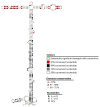Deep Learning Techniques to Characterize the RPS28P7 Pseudogene and the Metazoa- SRP Gene as Drug Potential Targets in Pancreatic Cancer Patients
- PMID: 38397997
- PMCID: PMC11154313
- DOI: 10.3390/biomedicines12020395
Deep Learning Techniques to Characterize the RPS28P7 Pseudogene and the Metazoa- SRP Gene as Drug Potential Targets in Pancreatic Cancer Patients
Abstract
The molecular explanation about why some pancreatic cancer (PaCa) patients die early and others die later is poorly understood. This study aimed to discover potential novel markers and drug targets that could be useful to stratify and extend expected survival in prospective early-death patients. We deployed a deep learning algorithm and analyzed the gene copy number, gene expression, and protein expression data of death versus alive PaCa patients from the GDC cohort. The genes with higher relative amplification (copy number >4 times in the dead compared with the alive group) were EWSR1, FLT3, GPC3, HIF1A, HLF, and MEN1. The most highly up-regulated genes (>8.5-fold change) in the death group were RPL30, RPL37, RPS28P7, RPS11, Metazoa_SRP, CAPNS1, FN1, H3-3B, LCN2, and OAZ1. None of their corresponding proteins were up or down-regulated in the death group. The mRNA of the RPS28P7 pseudogene could act as ceRNA sponging the miRNA that was originally directed to the parental gene RPS28. We propose RPS28P7 mRNA as the most druggable target that can be modulated with small molecules or the RNA technology approach. These markers could be added as criteria to patient stratification in future PaCa drug trials, but further validation in the target populations is encouraged.
Keywords: biomarkers; deep learning; gene copy number; gene expression; lethality; pancreatic cancer.
Conflict of interest statement
The authors declare no conflict of interest.
Figures




Similar articles
-
Claudin 7 as a possible novel molecular target for the treatment of pancreatic cancer.Pancreatology. 2019 Jan;19(1):88-96. doi: 10.1016/j.pan.2018.10.009. Epub 2018 Nov 2. Pancreatology. 2019. PMID: 30416041
-
Combined evaluation of a panel of protein and miRNA serum-exosome biomarkers for pancreatic cancer diagnosis increases sensitivity and specificity.Int J Cancer. 2015 Jun 1;136(11):2616-27. doi: 10.1002/ijc.29324. Epub 2014 Nov 25. Int J Cancer. 2015. PMID: 25388097
-
MicroRNA-296-5p Promotes Cell Invasion and Drug Resistance by Targeting Bcl2-Related Ovarian Killer, Leading to a Poor Prognosis in Pancreatic Cancer.Digestion. 2020;101(6):794-806. doi: 10.1159/000503225. Epub 2019 Sep 27. Digestion. 2020. PMID: 31563901
-
Pseudogene-Derived lncRNAs and Their miRNA Sponging Mechanism in Human Cancer.Front Cell Dev Biol. 2020 Feb 28;8:85. doi: 10.3389/fcell.2020.00085. eCollection 2020. Front Cell Dev Biol. 2020. PMID: 32185172 Free PMC article. Review.
-
Circular RNAs as novel potential biomarkers for pancreatic cancer.J Cancer. 2021 Jun 1;12(15):4604-4615. doi: 10.7150/jca.58640. eCollection 2021. J Cancer. 2021. PMID: 34149924 Free PMC article. Review.
References
-
- Cabasag C.J., Arnold M., Rutherford M., Bardot A., Ferlay J., Morgan E., Little A., De P., Dixon E., Woods R.R., et al. Pancreatic cancer survival by stage and age in seven high-income countries (ICBP SURVMARK-2): A population-based study. Br. J. Cancer. 2022;126:1774–1782. doi: 10.1038/s41416-022-01752-3. - DOI - PMC - PubMed
Grants and funding
LinkOut - more resources
Full Text Sources
Miscellaneous

